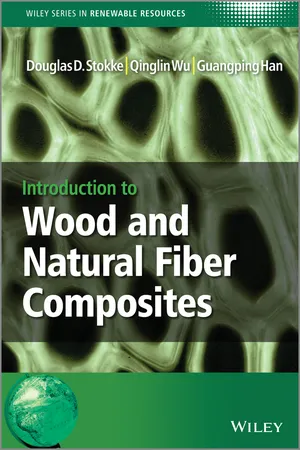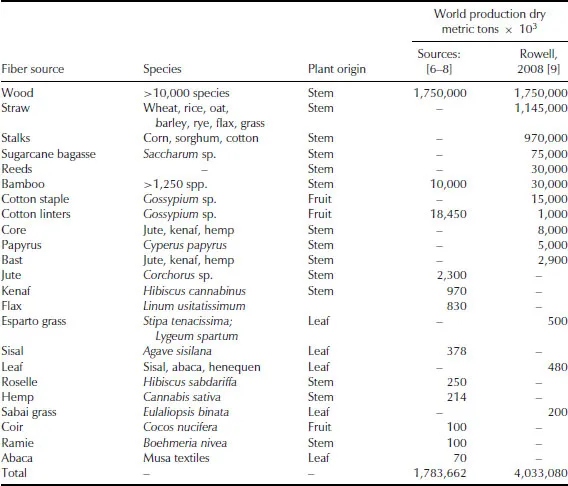![]()
1
Wood and Natural Fiber Composites: An Overview
1.1 Introduction
Societal needs for materials and infrastructure demand transformational change in processes and materials, driven by requirements for lighter-weight, energy-efficient, environment-friendly, carbon-sequestering, renewable, and sustainable solutions. This includes the methods and resources used in industry, construction, and consumer products, including those made from wood and other natural fiber. Although solid-sawn lumber and wood products remain vital from an economic and utilitarian standpoint, it is increasingly essential that the technology to create composite materials from renewable resources such as wood be understood, applied, and improved. Changes in the forest resource worldwide [1,2], along with growing demands for products due to economic development and increased human population, dictate that we produced and use materials having solid metrics of environmental performance [3].
In order to meet these challenges, wood is routinely combined with adhesives, polymers, and other ingredients to produce composites, thereby improving material properties while making more efficient use of the wood resource. Furthermore, although wood is still the primary plant-derived substrate for manufacturing structural building materials, cabinets, furniture, and a myriad of other products, many other botanical fiber sources are sought and utilized as supplements, substitutes, or alternatives to wood, often in some type of composite material. It is thus important for students of wood science and industrial technology to understand both the similarities and differences in the vast array of natural, plant-based raw material from which useful products can be manufactured.
1.2 What Is Wood?
If you were to ask the question “what is wood?” you might be greeted with incredulous looks. After all, is not the answer obviously simple? In some sense, the answer is yes; there is a certain simplicity with which the question may be approached, given the general familiarity with wood and its ubiquitous exploitation in many common applications. But, as is often true for many such “simple” topics, there can be much more to the answer than that which is immediately apparent. As an example, although it would be generally recognized that the trunk of an oak tree contains wood, what might be said of the material obtained from the stem of a coconut palm? While it may in some respects resemble the wood of trees, it is generally agreed that monocots such as coconut palm stems do not contain wood per se, but are said to be composed of “woody material.”
In light of questions such as that illustrated by the coconut palm, the following definition of wood serves the purposes of this book: “Wood is the hard, fibrous tissue that comprises the major part of stems, branches, and roots of trees (and shrubs) belonging to the plant groups known as the gymnosperms and the dicotyledonous angiosperms. Its function in living trees is to transport liquids, provide mechanical support, store food, and produce secretions. Virtually all of the wood of economic significance is derived from trees and, as timber, it becomes a versatile material with a multitude of uses. In addition, there are woody materials found in the stems of tree forms in another plant group, the monocotyledonous angiosperms, including the bamboos, rattans, and coconut palms. These woody materials are similar to wood in being lignocellulosic in composition, but they differ substantially in their anatomic structure” [4]. We thus distinguish between “wood” and “woody materials” primarily on the basis of anatomy.
1.3 Natural Fibers
1.3.1 Fibers
Generally, a “fiber” is an object that is elongated, with a length-to-diameter (L/D) ratio of somewhat greater than one. Although the term is used variously, one may think of natural fibers as any fibrous material that is extracted from the environment, be it a fiber derived from plant, animal, or mineral sources (Table 1.1). Natural fibers may be processed by hand, simple tools, or sophisticated industrial processes to render them useful for some purpose, but they are clearly distinguished from manufactured fibers that are synthesized. Rayon fibers, for example, are reconstituted chemically from the cellulose obtained from plants, but they are not generally viewed as “natural fibers” because of the degree of chemical processing required to form them. Similarly, fibrous materials generated from petrochemicals and carbon are obviously made from materials found in the environment, but since the raw material are not fibrous in their native state and are not extracted directly from living organisms, they are not considered as natural fibers.
Table 1.1 A classification of natural fibers.
This text focuses on principles applicable to plant materials (“vegetable” fibers) appearing on the left side of Table 1.1. Thus, the term “natural fiber” as used in this book will be understood to apply only to a subset of all possible natural fibers, that is, to fibers obtained from botanical sources. These sources may include either woody or nonwoody plants. Furthermore, the term “fiber” will be used in the broadest sense possible, in that it will be used to refer generically to plant substance in just about any geometric form one could imagine. As an example, it is common practice to refer to whole logs supplied to an industrial processing site as the fiber supply, even if the wood is intended for use in relatively whole form, such as lumber. This generic usage is in contrast to the more specific definition of a fiber as an object having a degree of slenderness defined by a specified ratio of length to diameter.
These basic terms or usages present an example of the perplexing nature of scientific and technical terminology. Many terms, such as fiber, may in fact have a specific scientific or technical definition, but within the industry or general field of practice, the term may be used in a broad nontechnical sense, and even in a manner contradictory to a technical definition. Indeed, the main focus of this text is on the concepts basic to the manufacture of composites via hot-pressing technology of “fiber” feedstocks that may be geometrically isodiametric, fibrous, laminar, or prismatic, and which may range in size from submicroscopic to large entities such as timber laminates.
1.3.2 Lignocellulosic Materials
Regardless of species-specific anatomic variations, vegetable or plant-based fibers share a similarity, in that their fundamental organic structural component is cellulose. Most vegetable fibers also contain, in varying chemical composition and content, the organic structural polymers hemicellulose(s) and lignin(s). Given these three major organic constituents, plant fibers are thus collectively termed lignocellulosic fiber(s), lignocellulosic material(s), or simply lignocellulose. Although it has become almost commonplace in some quarters to use the term lignocellulose as a noun, researchers caution against such usage, primarily because this implies that “lignocellulose” is sufficiently uniform as a material to be regarded as a singular substance. This notion is to be avoided, as one of the great challenges in the industrial use of lignocellulosic material is to understand the widely varying composition and attributes resulting from species differences, as well as the often considerable variation between individuals with a species and even within individual plants. In an effort to avoid oversimplification, this book will typically employ longer but preferred terms such as “lignocellulosic fibers” or “lignocellulosic materials” as opposed to the somewhat problematic term, “lignocellulose.”
There are many similarities in the chemical and physical characteristics of lignocellulosic fibers obtained from the myriad of botanic sources, but at the same time, it should be recognized that each plant source has its own unique chemical composition, anatomic structure, and resultant chemical, physical, and mechanical properties. However, in lieu of exploring in detail the characteristics of all natural fibers of potential industrial interest, wood will be used in this text as the primary example or exemplar of the properties and behavior of natural fiber. We do this for two reasons: (1) the availability of a considerable volume of research literature on wood chemistry, structure, properties, and utilization; and (2) the significance of wood as the leading plant material used by human societies worldwide.
1.3.3 Worldwide Lignocellulosic Fiber Resources
Table 1.2 presents estimates of plant fiber resources in the world. Some examination and explanation of these estimates are in order. First, notice that sum or total fiber estimate (bottom of table) is substantially different for the two columns. The primary reason for this difference is that the left column of Table 1.2 does not contain data for crop residues (e.g., straw and crop stalks). If crop residues are omitted from the right column, each estimate total is within approximately 7.5%.
Table 1.2 World production of natural fibers useful for composite materials.
Estimates of the kind we are considering here are often based on data from a variety of sources, including extrapolations based on cropland area, harvest data, and utilization surveys [9]. Thus, such estimates are not to be viewed precise, but as relative indicators of fiber supplies. Even in this light, it is apparent that in relative terms, the supply of wood fiber dwarfs that of any other single type of natural plant fiber. Observe that wood fiber comprises more than 98% of the total, omitting crop residues (Table 1.2, first data column). With straw and stalks included (second data column), wood comprises about 43% of the total. In either case, the significance of wood fiber is observed, making wood a worthy teaching exemplar on this basis alone. It is perhaps due to the abundance and resulting widespread use of wood that the preponderance of research information on wood as a material provides the major reason why wood is the primary teaching example we will use to highlight the characteristics of lignocellulosic materials in general.
1.3.4 Wood as a Teaching Example
The reader should keep in mind that when we discuss the various attributes of wood, many of the basic concep...


